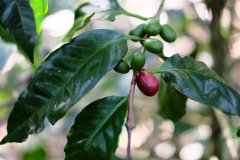A new method of fermentation is called carbon dioxide impregnation.
Professional coffee knowledge exchange more coffee bean information please follow the coffee workshop (Wechat official account cafe_style)

# anaerobic treatment and carbon dioxide impregnation
There is a new fermentation method that can produce an incredibly unique flavor, and it has gained rapid popularity. This fermentation method leads to anaerobic fermentation, which is called carbon dioxide impregnation. Let's break down the terminology first--
Anaerobic-anaerobic environment
Carbon dioxide-carbon dioxide rich environment
Immersion-A broader term than fermentation, referring to microbial metabolism
In a sense, anaerobic fermentation and carbon dioxide fermentation can be used interchangeably-both refer to fermentation in an environment with limited oxygen. You may also notice that the term "anaerobic fermentation" also refers to "anaerobic fermentation".
Throughout the history of full-washed coffee production, coffee fruits with pulp are usually soaked in open-air sinks, buckets, or plastic bags, a period known as "fermentation".
Its invention stems from function, not form. Farmers can use this method to remove sticky fruit mucus from coffee seeds, leaving only a layer of parchment to cover it. When removing fructose and pectin from coffee, it is most important for the change of coffee flavor. Now that we note the complexity of microbiology and its effect on flavor, more precise terminology is needed to help distinguish between the more specific methods traditionally used by farmers for fermentation.
When coffee farmers use the word "anaerobic fermentation", it usually means that they have created a closed environment. Normally, the coffee will remove the pulp as usual, and then the raw coffee beans with mucus and parchment are placed in this airtight container, which is usually made of stainless steel and equipped with a venting valve. In some cases, this fermentation method can traditionally be extended from 12-36 hours to a few days. The species of microorganisms that can survive in this environment and actively participate in fermentation are limited to those that can survive well in anoxic environment. The existence of these microorganisms may greatly change the final flavor of coffee. Some anaerobic coffees are incredibly accurate and highly recognizable, such as gingerbread, cinnamon, licorice, bubblegum or pears. The flavor brought by fermentation is often unique, highly expressive and unusual.
The main difference between anaerobic coffee fermentation and carbon dioxide impregnation is that in the carbon dioxide impregnation process, coffee cherries do not have to remove the pulp before entering the sealing tank. Carbon dioxide impregnation is a technical term put forward by the wine industry, in which the whole grape is fermented without squeezing the juice. This tends to produce fresh and fruity wines that are not long old but can be consumed after the brewing is finished.
For coffee beans treated with carbon dioxide impregnation, first, coffee cherries are screened to remove low-density coffee cherries floating on the surface of the water, and then added to an airtight container with an one-way valve, much the same as the anaerobic method. Because the pulp of coffee cherries is also put into a container to ferment together, it may take days or weeks to ferment. Different pressure levels in the container will produce different effective sugars and pectin for microbial consumption during the whole fermentation process. Near the bottom of the container, over time, the coffee cherry is gently pressed by gravity, while the top coffee cherry remains unpressed, and the whole fermentation process is slow and complete.
Important Notice :
前街咖啡 FrontStreet Coffee has moved to new addredd:
FrontStreet Coffee Address: 315,Donghua East Road,GuangZhou
Tel:020 38364473
- Prev

What are the better coffee brands? 2019 ranking of Chinese coffee chain brands
Professional coffee knowledge exchange more coffee bean information Please pay attention to the coffee workshop (Wechat official account cafe_style) consumption experience since we have chosen takeout, in addition to the quality of the coffee itself, the experience from placing an order to drinking to drinking is equally important, is it convenient and fast? Is it beautiful? Is it good value for money? Is the key to consider when ordering takeout. Moreover, the time of transportation,
- Next

Tell you what is the skill of coffee flower drawing | teach you the skill of coffee heart-shaped flower drawing for the first time
Professional coffee knowledge exchange more coffee bean information Please pay attention to the coffee workshop (Wechat official account cafe_style) Coffee pull is a craft of baristas, this technology has brought baristas some customer praise and self-pursuit. Guests will come to the restaurant to ask the barista to make leaves or loving flowers. The barista must be able to do exactly what the guests want.
Related
- Beginners will see the "Coffee pull flower" guide!
- What is the difference between ice blog purified milk and ordinary milk coffee?
- Why is the Philippines the largest producer of crops in Liberia?
- For coffee extraction, should the fine powder be retained?
- How does extracted espresso fill pressed powder? How much strength does it take to press the powder?
- How to make jasmine cold extract coffee? Is the jasmine + latte good?
- Will this little toy really make the coffee taste better? How does Lily Drip affect coffee extraction?
- Will the action of slapping the filter cup also affect coffee extraction?
- What's the difference between powder-to-water ratio and powder-to-liquid ratio?
- What is the Ethiopian local species? What does it have to do with Heirloom native species?

